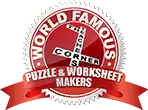 The Teacher's Corner
The Teacher's CornerPuzzles and Activities
During unit on great explorers...
Ask students how they believed sailors figured out that the world was round, and not flat. Take all answers. Tell them that one way was to watch the horizon and see how distant objects approached. What you see first/second and finally as something comes into view.
Columbus intuited the world was round by comparing the way butterfly wings looked on the edge of an orange with the approaching sails of ships as they came over the horizon. He and many others of his time knew this confirmed the roundness of the world (according to some of my research anyway).
Use the largest piece of citrus fruit you can find or any large round object. Make a "butterfly" out of paper. Demonstrate the ability to see more of the butterfly as it approaches, but that at first one only sees the tips of the wing. You don't see the whole butterfly looking small because of distance, you only see the top tips until it is on the horizon right in front of you.
SECOND: Have students peel the orange as best they can, leaving it all in one piece. (I do this in pairs). This represents the world. Once the peel is made, the peel can be flattened on a piece of centimeter squared paper and traced. Students can visualize how a globe can be turned into a flat map and the amount of distortion that can result.
Math follow up: Students count the "area" of the globe. Use reasoning and writing to determine total area and how they accounted for partial squares. Hope this makes sense. If not, email me directly.
Submitted by: Lili Malabed karlita@email-removed